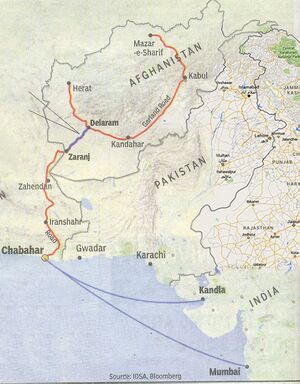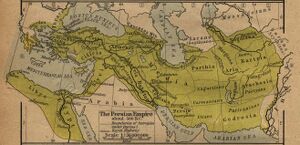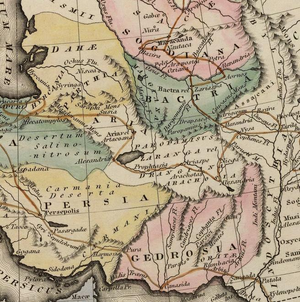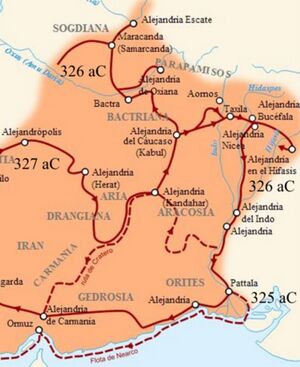Gedrosia
| Author:Laxman Burdak, IFS (Retd.) |




Gedrosia (गेडरोजिया) is the hellenized name of an area that corresponds to today's Balochistan. It may be identified with modern Gwadar in Pakistan. According to Arrian[1] the capital of Gedrosia was town named Pura, present Bampur (बमपुर) city in Sistan and Baluchestan Province, Iran.
Variants of name
- Gadrosia (Anabasis by Arrian, p. 196, 350-363, 374, 387. 196, 350-363, 374, 387.)
- Gedrosai
- Gadrosians
- Gedrosia (गेडरोजिया) (AS, p.295)
- Gedrusi (Pliny.vi.25, Pliny.vi.39)
Location
The area which is named Gedrosia, in books about Alexander the Great and his successors, runs from the Indus River to the southern edge of the Strait of Hormuz. It is directly to the south of the Iranian countries of Bactria, Arachosia and Drangiana, to the east of the Iranian countries of Persia and Carmania and due west of the Indus River which formed a natural boundary between it and Western India.
Jat clan
- Gadar
- Gidar will appear again among tribes of Balochistan, as Gidor and Gadara, representatives of the ancient Gedrosai of the Greeks.[2]
- Ora
Jat Gotras Namesake
Jat Gotras Namesake
- Gadrosia (Anabasis by Arrian, p. 196, 350-363, 374, 387. 196, 350-363, 374, 387.)
Mention by Pliny
Pliny[3] mentions The Indus...The greater part of the geographers, in fact, do not look upon India as bounded by the river Indus, but add to it the four Satrapies of the Gedrosi,13 the Arachotæ,14 the Arii,15 and the Paropauisidæ,16 the river Cophes17 thus forming the extreme boundary of India. All these territories, however, according to other writers, are reckoned as belonging to the country of the Arii. (21.)
13 Gedrosia comprehended probably the same district as is now known by the name of Mekran, or, according to some, the whole of modern Beloochistan.
14 The people of the city and district of Arachotus, the capital of Arachosia. M. Court has identified some ruins on the Argasan river, near Kandahar, on the road to Shikarpur, with those of Arachotus; but Professor Wilson considers them to be too much to the south-east. Colonel Rawlinson thinks they are those to be seen at a place called Ulan Robat. He states that the most ancient name of the city, Cophen, (mentioned by Pliny in c. 25 of the present Book), has given rise to the territorial designation. See p. 57.
15 The people of Aria, consisting of the eastern part of Khorassan, and the western and north-western part of Afghanistan. This was one of the most important of the eastern provinces or satrapies of the Persian empire.
16 This was the collective name of several peoples dwelling on the southern slopes of the Hindoo Koosh, and of the country which they inhabited which was not known by any other name. It corresponded to the eastern part of modern Afghanistan and the portion of the Punjaub lying to the west of the Indus.
17 It is supposed that the Cophes is represented by the modern river of Kabul.
Mention by Pliny
Pliny[4] mentions The Ariani and the adjoining Nations.....We then come to the nation of the Dorisdorsigi, and the rivers Pharnaracotis20, and Ophradus; and then to Prophthasia21, a city of the Zaraspades, the Drangæ22, the Evergetæ23, the Zarangæ, and the Gedrusi24;....
20 Ansart suggests that the river Pharnacotis is the same as the modern Ferrichround, and the Ophradus probably the Kouchround.
21 Ansart suggests that the modern name is Zarang. Parisot says that it is Corcharistan.
22 The inhabitants of Drangiana, a district at the eastern end of the modern kingdom of Persia, and comprehending part of the present Sejestan or Seistan.
23 They gave its name to the modern Eudras, according to Parisot.
24 It is doubtful whether these are the same as the Gedrosi, mentioned by Pliny in c. 23, 24. Parisot censures Hardouin for confounding them, and says that these inhabited the modern Bassar. In Dr. Smith's Dictionary, they are looked upon as the same people.
Mention by Pliny
Pliny[5] mentions The Ariani and the adjoining Nations..... Some writers will also have it that Daritis29 forms part of Ariana, and give the length of them both as nineteen hundred and fifty miles, and the breadth one half of that30 of India. Others again have spread the Gedrusi and the Pasires over an extent of one hundred and thirty-eight miles, and place next to them the Ichthyophagi Oritæ31, a people who speak a language peculiar to themselves, and not the Indian dialect, extending over a space of two hundred miles.
29 Situate, according to Ptolemy, in the eastern parts of Media.
30 For this measurement see c. 21.
31 Meaning the "Fish-eating Mountaineers." According to Parisot they occupied the site of the modern Dulcidan, and Goadel, which are bounded by mountains, whence the name.
Jat clans mentioned by Megasthenes
Megasthenes also described India's caste system and a number of clans out of these some have been identified with Jat clans by the Jat historians. Megasthenes has mentioned a large number of Jat clans. It seems that the Greeks added 'i' to names which had an 'i' ending. Identified probable Jat clans have been provided with active link within brackets. (See Jat clans mentioned by Megasthenes)
| Jat clans as described by Megasthenes | ||||||||||||
| Location | Jat clans | Information | ||||||||||
|---|---|---|---|---|---|---|---|---|---|---|---|---|
| 24. Beyond Indus
|
Four satrapies, --the Gedrosi (Gadar), Arachotae (Arak), Arii (Aria, Herat), Paropamisadae (Kabul valley)
|
Making the river Cophes (Kabul) its furthest limit; though others prefer to consider all these as belonging to the Arii (Aria) | ||||||||||
History
Following his army's refusal to continue marching east at the Hyphasis River in 325 BC, Alexander the Great crossed the area after sailing south to the coast of the Indian Ocean on his way back to Babylon. Upon reaching the Ocean, Alexander the Great divided his forces in half, sending half back by sea to Susa under the command of Nearchus.[6] The other half of his army was to accompany him on a march through the Gedrosian desert, inland from the ocean.[7] Throughout the 60 day march through the desert, Alexander lost at least 12,000 soldiers, in addition to countless livestock, camp followers, and most of his baggage train.[8] Some historians say he lost three-quarters of his army to the harsh desert conditions along the way.[9] However, this figure was likely based on exaggerated numbers in his forces prior to the march, which were likely in the range of no less than 30,000 soldiers.[10]
There are two competing theories for the purpose of Alexander the Great's decision to march through the desert rather than along the more hospitable coast. The first argues that this was an attempt to punish his men for their refusal to continue eastward at the Hyphasis River.[11] The other argues that Alexander was attempting to imitate and succeed in the actions of Cyrus the Great, who had failed to cross the desert.[12] The decision to cross the Gedrosian Desert, whatever his intentions, is regarded as the largest blunder in Alexander the Great's Asiatic campaign.
गेडरोजिया
विजयेन्द्र कुमार माथुर[13] ने लेख किया है ... गेडरोजिया (AS, p.295) 'मकरान' (पाकिस्तान) का यूनानी नाम है। रोम के इतिहास के प्रसिद्ध विद्वान् लेखक गिबन ने भी गेडरोजिया का मकरान से अभिज्ञान किया है। संभवत: यह नाम मकरान के प्राचीन बंदरगाह 'ग्वादूर' (संस्कृत-बंदर) का रूपांतर है। ग्वादूर अलक्षेंद्र के आक्रमण के समय तथा उसके पूर्व से ही गेडरोजिया का बंदरगाह था। अलक्षेंद्र पंजाब से यूनान वापस जाते समय मकरान के मार्ग से ही गया था। यूनानी लेखकों के वृत्तान्त से सूचित होता है कि गेडरोजिया निवासी मत्स्यभक्षक थे। यहाँ के समुद्र तट पर ह्वेल मछलियाँ बहुतायत से मिलती थीं। ह्वेल की हड्डियों से यहाँ के निवासी घर बनाते थे और इसके विशाल खुले जबड़ों से दरवाजों का काम लेते थे।
Ch.22: March of Alexander through the desert of Gadrosia.
Arrian[14] writes ...Again he took half of the shield-bearing guards and Agrianians, the guard of cavalry and the horse-bowmen, and marched forward to the confines of the Gadrosians and Oritians, where he was informed that the passage was narrow, and the Oritians were drawn up with the Gadrosians and were encamping in front of the pass, with the purpose of barring Alexander's passage. They had indeed marshalled themselves there; but when it was reported that he was already approaching, most of them fled from the pass, deserting their guard. The chiefs of the Oritians, however, came to him, offering to surrender both themselves and their nation. He instructed these to collect the multitude of their people together and send them to their own abodes, since they were not about to suffer any harm. Over these people he placed Apollophanes as viceroy, and with him he left Leonnatus the confidential body-guard in Ora,[1] at the head of all the Agrianians, some of the bowmen and cavalry, and the rest of the Grecian mercenary infantry and cavalry. He instructed him to wait until the fleet had sailed round the land, to colonize the city, and to regulate the affairs of the Oritians so that they might pay the greater respect to the viceroy. He himself, with the main body of the army (for Hephaestion had arrived at the head of the men who had been left behind), advanced into the land of the Gadrosians by a route most of which was desert. Aristobulus says that in this desert many myrrh-trees grew, larger than the ordinary kind; and that the Phoenicians, who accompanied the army for trafficking, gathered the gum of myrrh, and loading the beasts of burden, carried it away.[2] For there was a great quantity of it, inasmuch as it exuded from large stems and had never before been gathered. He also says that this desert produces many odoriferous roots of nard,[3] which the Phoenicians likewise gathered; but much of it was trampled down by the army, and a sweet perfume was diffused far and wide over the land by the trampling; so great was the abundance of it. In the desert there were also other kinds of trees, one of which had foliage like that of the bay-tree, and grew in places washed by the waves of the sea. These trees were on ground which was left dry by the ebb-tide; but when the water advanced they looked as if they had grown in the sea. Of others the roots were always washed by the sea, because they grew in hollow places, from which the water could not retire; and yet the trees were not destroyed by the sea. Some of these trees in this region were even thirty cubits high. At that season they happened to be in bloom; and the flower was very much like the white violet,[4] but the perfume was far superior to that of the latter. There was also another thorny stalk growing out of the earth, the thorn on which was so strong that, piercing the clothes of some men just riding past, it pulled the horseman down from his horse rather than be itself torn off the stalk. It is also said that when hares run past these bushes, the thorns cling to their fur; and thus these animals are caught, as birds are with bird-lime, or fish with hooks. However they were easily cut through with steel; and when the thorns are cut the stalk gives forth much juice, still more abundantly than fig-trees do in the springtime, and more pungent.[5]
1. Ora was the name of the district inhabited by the Oritians.
2. Cf. Pliny (Nat. Hist. xii. 33-35).
3. Cf. Strabo (xv. 2); Pliny (Nat. Hist. xii. 26).
4. Probably the snow-flake.
5. This is the well-known catechu, obtained chiefly from the Acacia Catechu. The liquid gum is called kuth or cutch in India. p.351-353 much juice, still more abundantly than fig-trees do in the springtime, and it is more pungent.’
Ch.23 March of Alexander through the desert of Gadrosia
Arrian[15] writes ... THENCE Alexander marched through the land of the Gadrosians, by a difficult route, which was also destitute of provisions; and in many places there was no water for the army. Moreover they were compelled to march most of the way by night, and a great distance from the sea. However he was very desirous of coming to the part of the country along the sea, both to see what harbours were there, and to make what preparations he could on his march for the fleet, either by employing his men in digging wells, or by making arrangements somewhere for a market and anchorage. But the part of the country of the Gadrosians near the sea was entirely desert. He therefore sent Thoas, son of Mandrodorus, with a few horsemen down to the sea, to reconnoitre and see if there happened to be any haven anywhere near, or whether there was water or any other of the necessaries of life not far from the sea. This man returned and reported that he found some fishermen upon the shore living in stifling huts, which were made by putting together mussel-shells, and the back-bones of fishes were used to form the roofs.1 He also said that these fishermen used little water, obtaining it with difficulty by scraping away the gravel, and that what they got was not at all fresh. When Alexander reached a certain place in Gadrosia, where corn was more abundant, he seized it and placed it upon the beasts of burden; and marking it with his own seal, he ordered it to be conveyed down to the sea. But while he was marching to the halting stage nearest to the sea, the soldiers paying little regard to the seal, the guards made use of the corn themselves, and gave a share of it to those who were especially pinched with hunger. To such a degree were they overcome by their misery that after mature deliberation they resolved to take account of the visible and already impending destruction rather than the danger of incurring the king’s wrath, which was not before their eyes and still remote. When Alexander ascertained the necessity which constrained them so to act, he pardoned those who had done the deed. He himself hastened forward to collect from the land all he could for victualing the army which was sailing round with the fleet; and sent Cretheus the Callatian 2 to convey the supplies to the coast. He also ordered the natives to grind as much corn as they could and convey it down from the interior of the country, together with dates3 and sheep for sale to the soldiers. Moreover he sent Telephus, one of the confidential Companions, down to another place on the coast with a small quantity of ground corn.
1. These people were called Ichthyophagi, or Fish-eaters. They are described by Arrian (Indica, 29); Curtius, ix. 40; Diodorus, xvii. 105; Pliny (Nat. Hist. vi. 25, 26); Plutarch (Alex. 66); Strabo, xv. They occupied the sea-ooast of Gadrosia, or Beloochistan. Cf. Alciphron (Epistolae, i. 1, 2).
2. A man of Callatis, a town on the Black Sea in Thrace, originally colonized by the Milesians.
3.Cf. Herodotus, i. 193.
Ch.24: March of Alexander through Gadrosia.
Arrian[16] writes ... HE then advanced towards the capital of the Gadrosians, which was named Pura1 ; and he arrived there in sixty days after starting from Ora. Most of the historians of Alexander’s reign assert that all the hardships which his army suffered in Asia were not worthy of comparison with the labours undergone here. They say that Alexander pursued this route, not from ignorance of the difficulty of the journey (Nearchus, indeed, alone says that he was ignorant of it), but because he heard that no one had ever hitherto passed that way with an army and emerged in safety, except Semiramis, when she fled from India. The natives said that even she emerged with only twenty men of her army; and that Cyrus,. son of Cambyses, escaped with only seven of his men2. For they say that Cyrus also marched into this region for the purpose of invading India, but that he did not effect his retreat before losing the greater part of his army, from the desert and the other difficulties of this route. When Alexander received this information he is said to have been seized with a desire of excelling Cyrus and Semiramis. Nearchus says that he turned his march this way, both for this reason and at the same time for the purpose of conveying provisions near the fleet. The scorching heat and lack of water destroyed a great part of the army, and especially the beasts of burden; most of which perished from thirst and some of them even from the depth and heat of the sand, because it had been thoroughly scorched by the sun. For they met with lofty ridges of deep sand, not closely pressed and hardened, but such as received those who stepped upon it just as if they were stepping into mud, or rather into untrodden snow. At the same time too the horses and mules suffered still more, both in going up and coming down the hills, from the unevenness of the road as well as from its instability. The length of the marches between the stages also exceedingly distressed the army; for the lack of water often compelled them to make the marches of unusual length.3 When they travelled by night on a journey which it was necessary to complete, and at daybreak came to water, they suffered no hardship at all; but if, while still on the march, on account of the length of the way, they were caught by the heat, the day advancing, then they did indeed suffer hardships from the blazing sun, being at the same time oppressed by unassuageable thirst.4
1. Pura was near the borders of Carmania, probably at Bampur. The name means town.
2. Cf. Strabo, xv. 2; Diodorus, ii. 19, 20. According to Megasthenes, Semiramis died before she could carry out her intended invasion of India. See Arrian (Indica, 5). Neither Herodotus nor Ctesias mentions an invasion of India by Cyrus; and according to Arrian (Indica, 9), the Indians expressly denied that Cyrus attacked them.
3. Strabo says that some of these marolies extended 200, 400, and even 600 stades; most of the marching being done in the night. Kruger substitutes ξυμμέτρους for ξύμμερτος ουσα.
4. Cf. Thucydides, ii. 49, 3.
Ch.27: March of Alexander through Carmania - punishment of viceroys.
Arrian[17] writes ... WHEN he arrived at the capital of Gadrosia (Pura), he there gave his army a rest. He deposed Apollophanes from the viceroyalty,1 because he discovered that he had paid no heed to his instructions. Thoas was appointed viceroy over the people of this district; but as he fell ill and died, Sibyrtius succeeded to the office. The same man had also lately been appointed by Alexander viceroy of Carmania;’ but now the rule over the Arachotians and Gadrosians was given to him, and Tlepolemus, son of Pythophanes, received Carmania. The king was already advancing into Carmania, when news was brought to him that Philip, the viceroy of the country of the Indians, had been plotted against by the mercenaries and treacherously killed; but that Philip’s Macedonian bodyguards had caught some of the murderers in the very act and others afterwards, and had put them to death. When he had ascertained this, he sent a letter into India to Eudemus and Taxiles, ordering them to administer the affairs of the land which had previously been subordinated to Philip until he could send a viceroy for it. When he arrived in Carmania, Craterus effected a junction with him, bringing with him the rest of the army and the elephants. He also brought Ordanes, whom he had arrested for revolting and trying to effect a revolution.2 Thither also came Stasanor, the viceroy of the Areians3 and Zarangians, accompanied by Pharismanes, son of Phrataphernes, the viceroy of the Parthians and Hyrcanians. There came also the generals who had been left with Parmenio over the army in Media, Cleander, Sitalces, and Heracon, bringing with them the greater part of their army. Both the natives and the soldiers themselves brought many accusations against Cleander and Sitalces, as for example, that the temples had been pillaged by them, old tombs rifled, and other acts of injustice, recklessness, and tyranny perpetrated against their subjects. As these charges were proved,4 he put them to death, in order to inspire others who might be left as viceroys, governors, or prefects of provinces with the fear of suffering equal penalties with them if they swerved from the path of duty5. This was one of the chief means by which Alexander kept in subordination the nations which he had conquered in war or which had voluntarily submitted to him, though they were so many in number and so far distant from each other; because under his regal sway it was not allowed that those who were ruled should be unjustly treated by those who ruled. At that time Heracon was acquitted of the charge, but soon after, being convicted by the men of Susa of having pillaged the temple in that city, he also suffered punishment. Stasanor and (the son of) Phrataphernes came to Alexander bringing a multitude of beasts of burden and many camels, when they learnt that he was marching by the route to Gadrosia, conjecturing that his army would suffer the very hardships which it did suffer. Therefore these men arrived just at the very time they were required, as also did their camels and beasts of burden. For Alexander distributed all these animals to the officers man by man, to all the various squadrons and centuries2 of the cavalry, and to the various companies of the infantry, as far as their number allowed him.
1. This man had been placed over the Oritians. See page 351 supra.
2. Curtius (ix. 41) says that Craterus sent a messenger to the king, to say that he was holding in chains two Persian nobles, Ozines and Zeriaspes, who had been trying to effect a revolt.
3. The Areians were famed for their skill as professional mourners. See Aeschylus (Choëphorae, 423). For the origin of the name see Donaldson (New Cratylus, sect. 81.)
4. εξηλέχθη is substituted by Sintenis for the common reading εξηγγέλθη.
5. According to Curtius (x. 1), Cleander and his colleagues were not slain, but put into prison; whereas 600 of the soldiers who had been the agents of their cruelty were put to death. Curtius says Oleander was spared for having killed Parmenio with his own hand. Cf. iii. 26 supra.
References
- ↑ Arrian Anabasis Book/6b, Ch.24
- ↑ An Inquiry Into the Ethnography of Afghanistan,p.111
- ↑ Natural History by Pliny Book VI/Chapter 23
- ↑ Natural History by Pliny Book VI/Chapter 25
- ↑ Natural History by Pliny Book VI/Chapter 25
- ↑ [A.B. Bosworth, "Conquest and Empire: The Reign of Alexander the Great." 1988. pg 139]
- ↑ [Ibid, pg. 142]
- ↑ [Ibid, pg 145]
- ↑ Plutarch, The Life of Alexander, 66.
- ↑ [A.B. Bosworth, "Conquest and Empire: The Reign of Alexander the Great." 1988. pg 146]
- ↑ [Waldemar Heckel, "The Wars of Alexander the Great." 2002. pg. 68]
- ↑ [A.B. Bosworth, "Conquest and Empire: The Reign of Alexander the Great." 1988. pg 146]
- ↑ Aitihasik Sthanavali by Vijayendra Kumar Mathur, p.295
- ↑ The Anabasis of Alexander/6b, Ch.22
- ↑ The Anabasis of Alexander/6b, Ch.23
- ↑ The Anabasis of Alexander/6b, Ch.24
- ↑ The Anabasis of Alexander/6b, Ch.27
Back to Jat Places in Pakistan
Back to Jat Places in Pakistan

